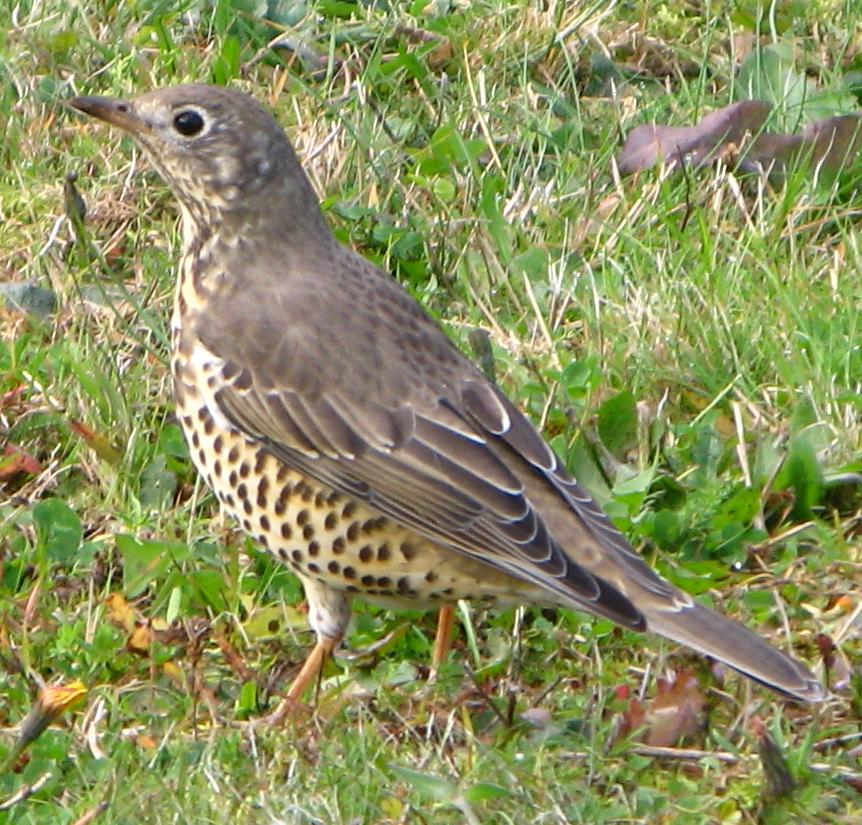Garden Wildlife
Garden Wildlife



What do they eat?
Mistle thrushes are insect and spider eaters in the summer and will take worms slugs and snails which they open on an anvil like song thrushes. In the winter they eat berries, especially holly, hawthorn and ivy. Their species name “viscivorus” means “eater of mistletoe” and this gives them their common name, but in Britain and Ireland mistletoe isn’t common enough to be a major food item.
Where do they breed?
They build nests in the crook of a tree branch or occasionally a building space, preferring open woodland, parks or large gardens where lawns give good feeding opportunities. They start breeding very early in the year and have two or sometimes three broods of 4 eggs between early March and June.
What do they do?
Like all thrushes they are ground feeders in part, but also are active in defending favoured berry-laden trees in the winter, aggressively chasing other birds from “their tree” – often a productive holly.
How are they doing?
Not well, their numbers have dropped by 60% since 1980 and seem still to be dropping. They are rated as Red for conservation status. There are thought to be 165,000 summer territories in Britain.
Finding out more:
BTO profile on mistle thrush
RSPB profile on mistle thrush
Page written and compiled by Steve Head
Mistle thrush Turdus viscivorus
The mistle thrush is a large and stroppy resident species which will breed in suitable large gardens, but is more likely to be seen in the winter. They are recorded in 7% of gardens.
What do they look like?
Our biggest thrush at 26-28cm, distinguished from the song thrush by its size, overall paler colour, greyish-brown upper parts and stance. The underside is pale but closely spotted and the sexes are alike Mistle thrushes have an upright, wary stance with their head held high
What do they sound like?
They have a loud song a bit like a blackbird’s but less attractive, and with repetition of short sequences. Their call is a rattling chatter. Males like to sing from tree tops like blackbirds.
Song Call

Stanislas Wroza, XC695842. Accessible at www.xeno-canto.org/695842.
Agris Celmins, XC691939. Accessible at www.xeno-canto.org/691939.
Mistle thrush Turdus viscivorus
The mistle thrush is a large and stroppy resident species which will breed in suitable large gardens, but is more likely to be seen in the winter. They are recorded in 7% of gardens.


What do they look like?
Our biggest thrush at 26-28cm, distinguished from the song thrush by its size, overall paler colour, greyish-brown upper parts and stance. The underside is pale but closely spotted and the sexes are alike Mistle thrushes have an upright, wary stance with their head held high
What do they sound like?
They have a loud song a bit like a blackbird’s but less attractive, and with repetition of short sequences. Their call is a rattling chatter. Males like to sing from tree tops like blackbirds.
Song Call
What do they eat?
Mistle thrushes are insect and spider eaters in the summer and will take worms slugs and snails which they open on an anvil like song thrushes. In the winter they eat berries, especially holly, hawthorn and ivy. Their species name “viscivorus” means “eater of mistletoe” and this gives them their common name, but in Britain and Ireland mistletoe isn’t common enough to be a major food item.
Where do they breed?
They build nests in the crook of a tree branch or occasionally a building space, preferring open woodland, parks or large gardens where lawns give good feeding opportunities. They start breeding very early in the year and have two or sometimes three broods of 4 eggs between early March and June.
What do they do?
Like all thrushes they are ground feeders in part, but also are active in defending favoured berry-laden trees in the winter, aggressively chasing other birds from “their tree” – often a productive holly.
How are they doing?
Not well, their numbers have dropped by 60% since 1980 and seem still to be dropping. They are rated as Red for conservation status. There are thought to be 165,000 summer territories in Britain.
Finding out more:
Page written and compiled by Steve Head
























